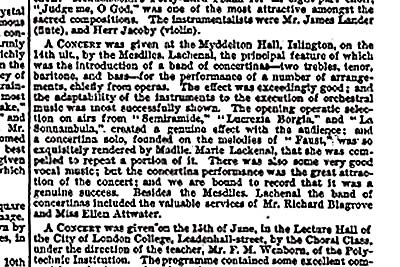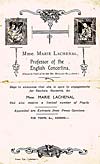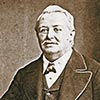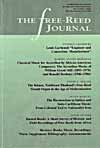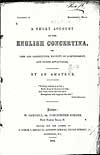|
Posted 15 November 2005
Marie Lachenal: Concertinist 1
Faye Debenham
and Randall C. Merris
I. Introduction
Marie Lachenal (1848-1937) had three claims to fame and social
prominence: one by birth, one by marriage, and one acquired as an accomplished
performer of classical music on the English concertina. Born to
the concertina by virtue of the family business—‘Louis Lachenal, Concertina
Manufacturer’, the firm established by her father in
1858 2 —Marie learned to play the
concertina and applied her talents to the promotion of Lachenal concertinas long
after her father’s death in 1861 and her mother’s divestiture of the
business in the early 1870s.
In 1868, Marie married Edwin A. Debenham (1844-1925), a
member of a family of photographers who specialized in portraits of
royalty, statesmen, and artists, as well as somewhat less illustrious clientele.
Founded by Edwin Debenham’s
father near the very dawn of photography, the family photography business bridged the nineteenth and twentieth
centuries and eventually produced three generations of Debenham photographers.
Edwin and Marie’s family was large by modern standards, with nine children
of whom eight survived infancy. And though Marie’s maternal responsibilities took a
toll on her career as performer and teacher, she still managed to maintain
high standards of performance throughout her absence from the stage for maternity and child-raising.
In fact, the advent of what might be called her ‘second career’ in the
1880s saw her garner the same high praise from the critics that she had received
in 1865-1866, when The Mesdemoiselles Lachenal—the teenagers Marie, Eugenie, and Josephine—first took the stage in London
and Edinburgh.
Marie Lachenal and sisters Eugenie and Josephine made their debut at
Myddelton Hall, in
Islington, on 14 June 1865,3
at the ages of sixteen, fifteen, and thirteen, respectively, perhaps while still studying
with Richard Blagrove (1826–1895), already a prominent concertina impresario by the
1860s and eventually the preeminent classical concertinist after the death of Giulio Regondi
in 1872.4
The sisters’ Islington performance drew a glowing review in the
Islington Times of 17 June 1865: 5
”… the Mdlles. Lachenal’s Concert is we believe the first entertainment available for
the million[s] in which the Concertina has been in a position fairly to challenge a
verdict on its merits as an orchestral instrument of surpassing beauty and extensive
capabilities. The Concert commenced with an operatic selection for five Concertinas
(two trebles, tenor, baritone and bass), of which the united effect was magnificent,
now resembling the tones of the organ, now more like a string band, preserving the
spirit of the airs, yet gracing them with novel charm…. Madlle Marie Lachenal was
deservedly encored after performing a splendid fantasia on the airs from [Gounod’s] “Faust” on
the Concertina with great taste and artistic effect; this one piece was sufficient to
entitle the Concert to a success but the enthusiasm of the audience rose higher still
on hearing a trio of Scotch airs for treble, baritone, and bass Concertinas by the
Mdlles. Lachenal … … … the performance gave evidence of much talent and finished
style and the Concert successfully demonstrated to the general public that which was
known only to a few enthusiastic amateurs—viz., the adaptability of the Concertina
to first-class orchestral Music, where this elegant instrument shines with peculiar
effect both in melody and harmony, and sustains the full score unaided by
instruments of any other description.”
And not only did Richard Blagrove attend the concert in order to lend support and enjoy the
accomplishments of his students, but he was one of the concertinists who
joined the sisters in the quintet that drew comment in the Islington Times review.
The fifth member of the quintet was Richard Blagrove’s older sister, Ellen
Attwater.6
In a letter to the editor of the South Hackney Correspondent for 27 July 1865,
an enthusiastic admirer of the English concertina paid the ultimate compliment,
placing them in the company of the finest concertinists of the
day: Giulio Regondi, Richard Blagrove, and George Case.7
Following the Islington performance in the summer of 1865, the Lachenal sisters headed to
Edinburgh for an October 1865 performance at the The Saturday Evening Concerts
at the Music Hall.8
Billed as ‘The Celebrated Performers on the ENGLISH
CONCERTINA’, the ‘act’ consisted of Marie, Eugenie, Josephine, and their
piano accompanist Frederick William Bridgman (1833–1892), an Edinburgh musician who also
played the concertina and joined the sisters for a concertina
quartet.9
What appears to have begun as a limited engagement lengthened
into an October-January stay, prompted by highly favorable reviews of their
performance:
The great novelty in the programme was the concerted pieces, arranged for three
and four Concertinas—the first occasion, we believe, in which such a combination has
been heard in Edinburgh. The effect was exceedingly good, more especially in the
operatic selections and the national airs. The first quartett, on themes from
[Rossini’s] “Semiramide,” [Bellini’s] “Sonnambula,” and [Donizetti’s] “Lucrezia Borgia,” played by the sisters Lachenal
and Mr. Bridgman, was most satisfactory both as to its arrangement and
performance. Mdlle. Marie Lachenal’s solo on airs from [Gounod’s] “Faust” was also worthy of all
praise for the tasteful and artistic manner in which it was rendered. Not less effective
was the duet on subjects taken from [Meyerbeer’s] “Les Huguenots,” played by Mdlles. Marie and
Eugenie on treble and tenor concertinas. The trio on national melodies, as might be
expected met with an enthusiastic reception, and was re-demanded. Mdlles.
Lachenal are unquestionably proficient on their respective instruments… (The Scotsman,
22 October 1865).10
The successful performance on 21 October was followed by a Saturday Evening
Concert at the Music Hall on 11 November; this performance received a round of
accolades and an announcement of the sisters' extended stay in Edinburgh:
The concertina playing of the Mdlles Lachenal and Mr Bridgman formed a most
important feature in the concert. The quartette on airs from [Donizetti’s] L’Elisir d’ Amore was
exceedingly effective. It is cleverly arranged, and was most tastefully interpreted by
Mr Bridgman and his fair co-executants. The duet on airs from [Auber’s] Le Domino Noir, &c,
for treble concertina and pianoforte, was also most charmingly given by Mdlle Marie
Lachenal and Mr Bridgman. The trio on Scottish airs by the three sisters was equally
satisfactory, and received an encore, which, however, was gracefully declined. Their
concluding number was the quartette introducing “Rule Britannia,” “Home, sweet
home,” and “God save the Queen.” During the performance of the National Anthem
the audience remained seated—a phenomenon we never saw exhibited in any
concert-room. We are glad to learn that these accomplished artistes intend to remain
some time in Edinburgh, so that we may hope to have frequent opportunities of
hearing them (The Scotsman, 13 November 1865).
The Lachenals’ next performance at the Music Hall’s Saturday Night Concerts
took place on 16 December and, like the earlier ones, was loudly applauded:
Two concert solos, the one on national airs and the other on themes from [Rossini’s] William
Tell, were tastefully played by Mdlle Marie Lachenal, and met with immense
applause. Not less satisfactory as performances were the trio, by the three sister,
and the quartett, [Weber’s] “Invitation a la Danse,” in which they were assisted by Mr
Bridgman … [who] discharged his usual duties as accompanist most
efficiently (The Scotsman, 18 December 1865).
Between their major performances, the Lachenal sisters contributed their
talents to charity events, including a 13 December concert for the benefit of the
Edinburgh Lifeboat Fund. The concert organizers were
disappointed by the low turnout, but certainly not by the quality of the sisters’
performance:
The concertina, played by Mdlles. Lachenal and Mr Bridgman, was worthy of all
praise, and loudly applauded, the quartette from [Donizetti’s] L’Elisire d’ Amore and the trio on
Scotch and Irish airs being re-demanded (The Scotsman, 14 December 1865).
Between their engagements at the Music Hall, the sisters also appeared at a ‘grand
musical soirée’ sponsored by the Total Abstinence Society and Band of Hope and
held at the Corn Exchange Hall, Dalkeith, on 25 December. The sisters shared the
instrumental segment of the program with the Band of the Edinburgh Volunteers.
It was, however, Christmas Night, and there were no more than eight hundred in attendance,
half of whom were children. But the sisters played to their full-house standards
and, as usual, their talents and efforts were rewarded by the reviewer:
The most attractive feature in the evening’s proceedings was the musical portion of
the programme, which included a variety of excellent quartetts, trios, and solos for
the concertina, which were admirably performed by Madlles Marie, Eugenie, and
Josephine Lachenal. … Mr F.W. Bridgman … performed the duties of
accompanist in his well-known superior style (The Scotsman, 27 December 1865).
The Lachenal sisters’ last performance in Edinburgh took place on 20 January
1866, once again as part of The Saturday Evening Concerts. And though they treated the audience
to at least some pieces not included in their earlier
performances at the Music Hall, they went unrewarded by the press. It appears
that their last performance was not reviewed, at least not by The Scotsman,
possibly because they were leaving Edinburgh and were therefore less newsworthy
than when future appearances loomed.
Marie and her sisters had little opportunity to capitalize on
their successes. In 1868, Marie left the Lachenal household to set up housekeeping of her own with husband
Edwin, and the Lachenal sisters trio was disbanded. Not until around 1920, when the Fayre Four Sisters—Inga, Tina,
Sylvia, and Lillian Webb—took to the stage,11
would there be another all-sister concertina ensemble of the same
high-caliber as the Lachenal sisters.
The years from 1869 to the early 1880s were devoted to the Debenham
children, which left little time for the concertina even in the parlor. Yet the later resurgence of
Marie’s career suggests that she at least found time to maintain
(possibly even add to) her technique with regular or occasional practice and
through teaching both her own children and perhaps other pupils as well. If Marie
performed outside the home at all, it was probably at very small, fairly
informal venues somewhat akin to the charity concerts in the mid-
1860s. Perhaps an exception to this was an occasional appearance at the series of
concerts that Richard Blagrove liked to organize in connection with his Concertina Fund,
these sometimes requiring forces of up to eight
concertinas.12
We can catch a glimpse of the day-to-day stress of Marie’s life from an extract
drawn from a family diary (now in the possession of the Debenham family) and dating from 1876:
Marie, pregnant with her 5th child, had joined Edwin in Weymouth where he was
establishing a new business. In February [1876] … he took time to visit his
favourite brother Arthur, in Ryde, where he worked by lamplight each evening,
painting an opal picture which would be sent as a specimen. About ten days after he
left the Isle of Wight, Marie sent a note to her brother-in-law requesting he come
immediately to visit his brother Edwin, who had been stricken with a condition known
as erysipelas [known as ‘St. Anthony’s Fire’, a viral infection].
Arthur left Ryde by train and within hours found his special brother
in a delirious state with a fever ranging from gentleness in lucid intervals to raging at
its height. This was an extremely anxious time for Marie as her sister Eugenie was in
another room confined with scarlet fever. Finally Elizabeth Lachenal arrived from
London with another brother of Edwin’s to assist.
Edwin took months to regain his strength and, within a few months, Marie
gave birth to Albert Debenham’s father,
Frederick, in Weymouth, 23 April 1876.13
In 1885, Marie reappeared among the ranks of the leading
concertinists. The occasion was the International Inventions
Exhibition in London, which brought out the flock of high-profile
concertinists from the ‘stables’ of both Wheatstone and Lachenal.
The concertina activities at the Exhibition were recorded as follows:
At the Inventions Exhibition Messrs. Wheatstones’ Recitals, by Mr. G. [sic!]Blagrove, Mr. J.
C. Ward, and the Messrs. Chidley, were greatly admired, and the Quartettes which
were played on the Treble, Tenor, and Bass Concertinas showed the beautiful effect
of concerted music, when performed on the Concertinas, and by competent
musicians. The solos were also artistically rendered. Again, there were the Recitals
by Mr. James Alsepti, Mr. Henry Roe, Mr. George Roe, and Madame Debenham,
under the direction of Messrs. Lachenal and Co., the various solos (some of them
comprising the most difficult music) being accomplished on this instrument in a
manner that would take a good Violinist to excel.14
That Marie must have held her own in the midst of this all-star cast is
evidenced by the following review:
A concert given to prove the pure and brilliant quality of the Lachenal concertina
afforded much gratification to the large audiences in the music-room of the
International Inventions Exhibition last Tuesday evening. … Marie Lachenal … played
fantasias from Gounod, Rossini, and Meyerbeer, with consumate [sic] ease, and was
deservedly applauded.15
(Note added after original publication.)
Another review from the same period reveals that Marie appeared with one of her daughters accompanying
her on the piano:
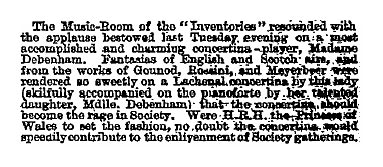 The Penny Illustrated Paper, London, 1 August 1885, page 71.
The Penny Illustrated Paper, London, 1 August 1885, page 71.
The Music-Room of the “Inventories” resounded with the applause bestowed last Tuesday evening on
a most accomplished and charming concertina-player, Madame Debenham. Fantasias of English and Scotch airs,
and from the works of Gounod, Rossini, and Mayerbeer were rendered so sweetly on a Lachenal concertina by
this lady (skilfully accompanied on the pianoforte by her talented daughter, Mdlle. Debenham) that the concertina
should become the rage in Society. Were H.R.H. the Princess of Wales to set the fashion, no doubt the
concertina would speedily contribute to the enlivenment of Society gatherings.
This daughter must have been Marie’s oldest, Lucy Alice, who was born in 1869 and thus would have been
about 16 years old when she appeared with her mother—just about the same age as her mother had been
at those early concerts in Islington and Edinburgh.
(Thanks to Robert Gaskins for this clipping.)
We can see what Marie looked like at this time from a seated portrait showing her
with concertina in hand; the portrait was made by husband Edwin at the Debenham studio just
around the time of the Exhibition (Fig. 1).
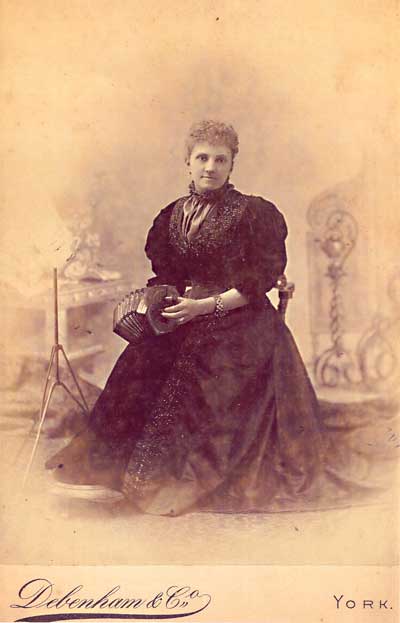 Courtesy of the Debenham Family
Courtesy of the Debenham Family
(Click on photo for larger image.)
Figure 1. Marie Lachenal with concertina
(photograph by Edwin A. Debenham, Debenham & Co., York , c. 1885).
The positive response to her appearance just a few years after the birth of her last
child, Elsie Linda, in 1882, must have provided a psychological boost. And Marie began to look forward to
a ‘second’
full-fledged career as a concertinist. In the next two decades, she earned acclaim from new
audiences from Huddersfield and Leeds in the north to
Southampton and Torquay in the south, all the while continuing to take on concertina
pupils.
Around the turn of the century,
Marie reinforced her efforts to promote her career by having an
‘‘announcement’’
printed that advertised her availability as both performer and
teacher, and followed the announcement (see Fig. 2) with a number of choice excerpts from reviews
that she had clipped from the press, a selection from which
follows:16
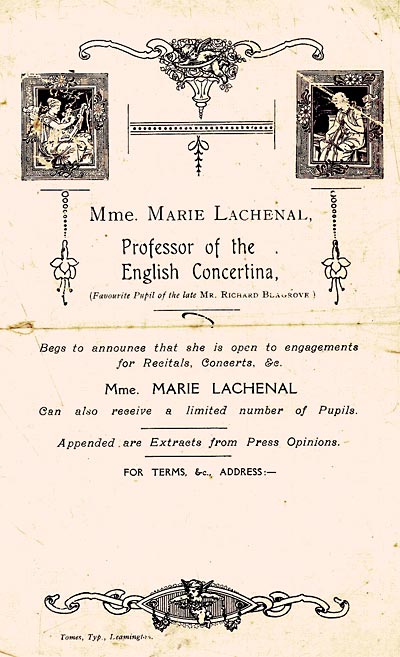 Courtesy of the Debenham Family
Courtesy of the Debenham Family
(Click on photo for larger images
of all pages in PDF format.)
Figure 2. Marie’s Announcement, c. 1900.
Mme. Marie Lachenal performed R. Blagrove’s concertina solo ‘Scottish Airs’ in a
manner which delighted the audience, who insisted on its repetition.—Southampton Times.
Winter Garden Concerts.—Foremost amongst those on Monday evening was Mme.
Marie Lachenal, whose solos ‘Les Hugenots [sic],’ ‘Le Prophéte,’ and ‘Fantasia on airs
from Faust,’ again proved her thorough acquaintance with the concertina, and the
applause with which she was greeted shewed that this lady has won her way to
popular favour.—Torquay Times.17
Mme. Marie Lachenal again sustained the reputation she has gained on more than
one occasion for the masterly way in which she handles the English concertina, and
her ‘Scotch Airs’ were loudly applauded.—Devon County
Standard.18
Mme. Marie Lachenal showed herself to be a very facile and correct executant, and
an accomplished artiste in her style of playing, her accent and phrasing being
particularly good, and her ability in bringing out the dramatic side of the music was
really remarkable. Indeed, she showed what a wonderful variety of tone and
expressiveness can be obtained from the instrument by a good player.—Huddersfield
Examiner.
The Coliseum Saturday Concerts.—The feature of the performance was the rendering
of a couple of concertina solos by Mme. Marie Lachenal, of Huddersfield, in such a
manner as to win the hearty applause of the audience. Her fingering of the
instrument was perfect. She is the best performer of the kind we have heard for
some time. —Leeds Daily News.19
Leeds Coliseum Saturday Concerts.—A novelty in the evening’s entertainment, and
one which will bear repeating was a concertina solo by Mme. Marie Lachenal, who
succeeded in drawing music from the instrument which few would have given credit
for possessing.—Leeds Mercury.
Dating from the turn of the century is another portrait of Marie with her concertina (Fig. 3).
Produced by husband
Edwin, it roughly coincided with Marie’s
announcement of her
continuing availability for performances and teaching.
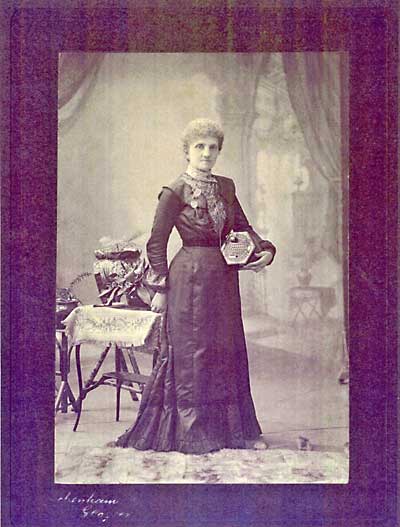 Courtesy of the Debenham Family
Courtesy of the Debenham Family
(Click on photo for larger image.)
Figure 3. Marie Lachenal with concertina
(photograph by Edwin A. Debenham, Debenham Studios, Gloucester, c. 1900).
III. The Musical Repertory
Thanks to the many references to specific pieces in the announcements and reviews of her
concerts in the 1860s and in the 1880s through the turn of the century, we can form a fairly good picture
of Marie’s repertory. the Appendix lists all the pieces culled from those announcements and reviews.
IV. The Lachenal and Debenham Families
Marie Lachenal was born on 13 August 1848 in the family home at 26 King
Street (now part of Shaftesbury Avenue),
London,20
and was christened on 11 February 1849 at St. Anne’s, Soho,
London. She was the first of nine children born to Louis (1821–1861)
and Elizabeth Lachenal (1825–1904), born Jeanne (or Françoise) Marie
Elisabeth Irion.21
Louis and Elizabeth married on 3 November 1847,
probably in Elizabeth’s hometown of Ferney Voltaire (France), but possibly across the border
in Geneva, Switzerland (given that Louis was Swiss-born). They departed for London shortly thereafter,
arriving there on 10 November 1847. (Louis had originally settled in England in December 1839.)
The Lachenals’s eight other children were Jane Elizabeth (23 July 1849–2 March 1883), who
adopted the stage name Eugenie; Josephine (b. 28 January 1851),
the third of the concertina-playing sisters; Louis Jules (b. 16 May 1853);
Constance (b. 19 August 1855), François Edouard (b. 27 July 1856); Marie
Louise (b. c. 25 October 1857); Alice (b. 27 November
1859); and Alexander (b. 17 October 1861). Louis Lachenal died on 18 December 1861,
just three years after beginning to market concertinas under his own name (rather than
wholesaling to Wheatstone) and moving his operations to 8, Little James Street, Bedford
Row, London, WC, along which street Lachenal concertinas would be manufactured for the next
seventy-some-odd years.22
After Louis’ death, Elizabeth mananged the firm until 1873,
at which time she sold the business to a group of the Lachenal
employees, who changed the name to
Lachenal & Co.23
Elizabeth then spent three
decades in retirement, and died on 10 September 1904 in the home
of daughter Marie Louise Waddell in Stout Green, North London.
To return to Marie: by 1867 she had met and fallen in love with
Edwin Alfred Debenham, who, having a fine voice, was also something of a performer, and
often sang at public concerts. Marie and Edwin married on 7 April 1868 in St.
Peters Church, Regent Square,
London.
Edwin was
born on 7 June 1844 in Bury St. Edmunds, Suffolk, where the Debenham family
was long established and well
known.24
He was the seventh of eight children
born to Samuel and Salome Debenham (born Warren). Recognizing the
opportunities stemming from the recent advancements in photography and with something of an artistic
flair of his own, Samuel Debenham had moved his family to London in 1846 to pursue a
career as a photographer. By 1860, he was well established with
his own studios, having learned much about the new art form, which he then taught to his
sons.
By 1862, Edwin A. Debenham and younger brother Arthur were working for
their older brother, William Elliott Debenham (age twenty-three), who had already set up
a successful studio at 158 Regent Street, London. In 1867, Edwin and
Arthur formed a partnership and set up a studio of their own in Ryde, Isle of Wight. Within a
year, though, Arthur had married, and Edwin agreed to withdraw from the partnership,
though not without a cash settlement. The Isle of Wight became the center of Arthur’s business and an
opportune site for advancing the Debenham slogan of ‘Photographer to Royalty’.
Indeed, Arthur was a favorite photographer of King Edward VII and H.R.H. Queen Alexandra
when they resided at Osborne House, their summer home, or went sailing on the Royal
Yacht ‘Victoria’.25
In addition, Arthur produced a
family portrait of Tsar Nicholas II and Tsarina Alexandria, taken during the Russian
royal family’s last visit to England in 1910.
Edwin’s older brother, William Elliott, preferred to operate mainly from his
Regent Street studio, which was an ideal location for attracting such
high-profile clients as members of the royal family, prime ministers, poets, and
artists. Edwin chose a decentralized approach, expanding his operations
around England, especially (but not exclusively) along the southern coast.
Among his locations: the early studio in Reigate, Surrey, as well as
E. Debenham (later Debenham & Gould), Glen View
Studios in Bournemouth,26
E.
Debenham (later Debenham & Smith) in Southampton, E. Debenham’s
‘Royal Portraits Studio’ in Weymouth, Debenham & Co. in York, and
the Debenham studios in Torquay and
Gloucester.
The Debenham studios also
reached north to Edinburgh, where Edwin had a studio that would later
belong to his son and namesake, Edwin Holford Debenham
(c. 1872 -1936).27
A number of calling cards and cabinet cards produced at the studios of
Edwin, his brothers, and their sons may still be found among
collectors.28
A particular
passion of Edwin Debenham was the pleasure of photographing
Marie and his children. In addition to portraits of Marie with her Lachenal concertina
(see Figures 1 and 3), Edwin produced a cameo-mount portrait of her at age seventy.
Shown in Figure 4, it dates from 1919.
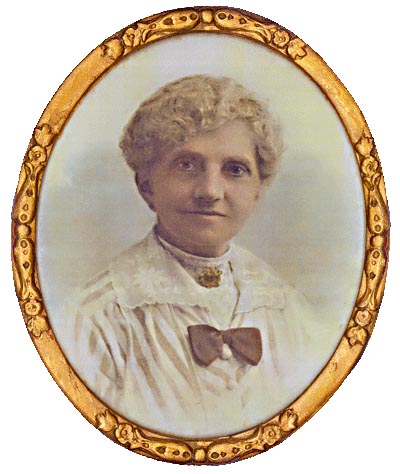 Courtesy of the Debenham Family
Courtesy of the Debenham Family
(Click on photo for larger image.)
Figure 4. Marie Lachenal
(photograph by Edwin A. Debenham, Debenham Studios, 1919).
In 1869, with Marie at his side, Edwin opened his studio in Reigate, Surrey.
At the same time, the family began to grow with the arrival of their first child, Lucy Alice.
Their first son, Arthur Jules, was born in late 1870, and seven more children arrived
during the next twelve years: Edwin
Holford (c. 1872-1936), Leonard
(b. 1874),29
Frederick William
(1876–1956),30
Philip Eugene (b. c. 1877), Leonard Coleman (b. c. 1879),
Josephine (b. 1880), and Elsie Linda (1882-1967), their
places of birth seemingly following the path of Debenham studios across
England.
The 1871 census shows that Marie and Edwin’s residence was in
Reigate. A decade later, the family was located in Holford, Holdenhurst,
near Bournemouth, whereas the 1891 census
has the family at 24 Newton
Lane, Castlegate District, York, and records Edwin and Marie as ‘Photographer[s]’.
The 1901 census places Marie , Edwin, and
three of the children in
Gloucester; by 1920, Marie and Edwin were residing in Nottingham.
Though Marie taught the concertina to some of the children, none of them followed her
as a professional concertinist.
Nonetheless, the 1901 British census records both Josephine (then age twenty) and Elsie
Linda (age eighteen) as ‘Musical student[s]’, with Josephine eventually having
a career as a music teacher.
Finally, retirement took Edwin and Marie to Darlington, in northern
England (a few miles south of Durham). This was a time for Edwin, patriarch of a family with deep religious
convictions, to direct his energies to the church, where he was a lay reader. Edwin
died on 21 February 1925 at their home on Northgate Street; and after
a widowhood of twelve years, Marie Lachenal died on 29 May 1937, at age 88. She
was buried on 1 June 1937 in the Darlington East Cemetery, Geneva
Road, Darlington.
Appendix: Marie Lachenal’s Repertory
What follows is a list of pieces that constitute at least part of Marie Lachenal’s repertory,
as these may be culled from the Islington Times review of her 1865 concert, the announcements
and reviews of the 1865/66 Edinburgh concerts that appeared in The Scotsman, and the reviews
that appeared in various newspapers of the concerts that Marie gave in the 1880s and later. The
great majority of works—both for concertina with piano and for concertina ensembles—belong
to the almost-proverbial ‘Fantasia on …’ genre, that is, settings of well-known songs
and popular opera arias of the day that were intended to display the performer’s virtuosity. In
some instances, it is not possible to identify the composer with certainty, as more than one concertinist-composer/arranger
drew on the same ‘common stock’ of materials. We have, therefore, attributed pieces as follows:
(1) when the composer is named in either an announcement or a review, his name is indicated together with
an asterisk; (2) when a title can be assigned to more than one composer (that is, more than one composer
wrote a piece with the same title, based on the British Library’s online catalogue or Wheatstone’s
Catalogue of Music for the English Concertina or Æola, c. 1919), we have favored the piece
by Blagrove (as long as it is known to date from before the concert in question) on the grounds of his
close relationship with Marie Lachenal. Publication dates follow those in the British Library online
catalogue. Finally, the list is organized by type of ensemble.
- A. Treble concertina and pianoforte
- Concertante Duet on Airs from ‘Le Domino’, ‘Fra Diavolo’, and ‘Masaniello’, Blagrove and Sydney Smith* (n.d.)
- Duet on airs from Herold’s ‘Zampa’, Blagrove (1862)
- Fantasia on Airs from Donizetti’s Opera ‘Linda di Chamounix’, Blagrove (1848)
- Airs from Gounod's [Opera] ‘Faust’, Blagrove* (1863)
- Fantasia on Airs from Meyerbeer’s Opera ‘Le Prophéte’, Blagrove (1851)
- Fantasia on Airs from Meyerbeer’s Opera ‘Les Huguenots’, Blagrove (1851)
- Fantasia on Airs from Rossini’s Opera ‘Guillaume Tell’, Blagrove (1855)
- Fantasia on Airs from Schira’s Opera ‘Niccolò di Lapi’, Blagrove (1863)
- Fantasia on Airs from Verdi’s Opera ‘Il Trovatore’, Blagrove (1856)
- Fantasia on English Airs
(including ‘The Ploughboy,’ ‘The Banks of Allan Water,’ ‘Cherry Ripe,’
and ‘The Roast Beef of Old England’), Blagrove (no copy in the British Library, but a full copy
online here)
- Fantasia on Scottish Airs, Blagrove (1854)
- Fantasia on ‘Souvenir de Donizetti’, Blagrove (1867)
- Serenade, Regondi*
(1859)31
- B. Concertina ensembles
- Invitation à la Danse, probably based on the famous piece by Carl Maria von Weber (two trebles, tenor, and bass)
- Mozart, Quartet in F major [K. 590] (two trebles, tenor, and bass)
- Quartet on Airs from [Donizetti’s] ‘Elisire d'Amore’, George Case* (two trebles, tenor, and bass)
- Quartet on English Airs, (including ‘Rule Britannia ‘, ‘Home, Sweet Home’, and ‘God save the Queen’),
George Case* (two trebles, tenor, and bass)
- Selections from Meyerbeer’s Opera ‘Les Huguenots’ (treble and tenor)
- Selections from Rossini’s Opera ‘Il Barbiere di Siviglia’ (two trebles, tenor, and bass)
- Selections from Rossini’s Opera, ‘Guillaume Tell’, Blagrove (treble and tenor)
- Themes from [Rossini’s] ‘Semiramide’, [Bellini’s] ‘Sonnambula’, and [Donizetti’s] ‘Lucrezia Borgia’
(two trebles, tenor, and bass)
- Trio on Scotch Airs, (including ‘Logie o'Buchan’, ‘Comin' thro' the Rye’, ‘Within a mile o' Edinburgh
toon’, ‘The Birks o' Aberfeldy’, and ‘Whistle and I'll come tae ye, my lad’), George Case* (treble, baritone, and bass;
or two trebles and bass)
- Trio on Scotch and Irish Airs, (including ‘We'll gang nae mair to yon Toun’, ‘Oft in the Stilly Night’,
‘My Boy Tammy’, and ‘The Campbells are Comin’), George Case* (two trebles and bass)
- C. Treble concertina and strings
- Beethoven, Serenade (likely that in D major, Op. 8, 1797, with viola and cello)
- English Airs (with violin, viola, and cello)
- Mayseder, Duet No. 1 (with violin)
- Mozart, Quartet No. 23 [in F major, K. 590] (with violin, viola, and cello)
Authors
Faye Debenham
(
)
was born in Western Australia and immigrated to British Columbia, Canada. Though Vancouver
was a step in a “working holiday” around the world, it was there that she met
and married Albert Debenham and, most latterly, enjoyed a career encompassing politics and
government circles. Sparked in part by her husband’s tale of two grandparents of artistic
merit—grandfather Edwin, a prominent Victorian photographer, and grandmother Marie
(Lachenal), a kind and gentle lady “who played the concertina”—she undertook
research on the Debenham family, which in turn led to research on the concertina and the
partnership with her co-author.
Randall C. Merris
(
)
is an economist at the
International Monetary Fund and an amateur Anglo concertinist. He has been an
economist at the Federal Reserve Bank of Chicago; has taught economics and
finance in the Kellogg Graduate School of Management, Northwestern University;
and has consulted with Asian governments on economic policy and financial
reform. He writes mainly on economics and occasionally on the concertina and
its history.
Have feedback on this article?
Send it to the authors.
The original version of this article appeared in
Papers of the International Concertina Association (PICA),
Vol. 2 (2005), pp. 1–17. PICA is published by
The International Concertina
Association (ICA)
and
The Center for the Study
of Free-Reed Instruments (CSFRI)
at The Graduate Center of The City University of New York.
Reprinted from the Concertina Library
http://www.concertina.com
© Copyright 2000– by Faye Debenham and Randall C. Merris
|
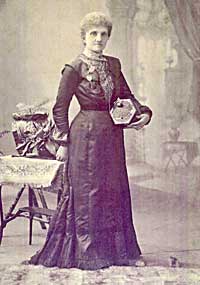
Marie Lachenal with
concertina, circa 1900,
in a photograph taken by her
husband, Edwin Debenham
Contents
The original version of this article appeared in
Papers of the International Concertina Association (PICA),
Vol. 2 (2005), pp. 1–17. PICA is published by
The International Concertina
Association (ICA)
and
The Center for the Study
of Free-Reed Instruments (CSFRI)
at The Graduate Center of The City University of New York.
© 2005 Faye Debenham
and Randall C. Merris.
Links to related documents
-
 The Lachenal Sisters Visit Edinburgh, 1865–1866
The Lachenal Sisters Visit Edinburgh, 1865–1866
-
by Robert Gaskins
-
At Christmas of 1865–1866, three young daughters of the late Louis Lachenal gave a
series of concerts in Edinburgh introducing “concerted music” played
on treble, tenor, and bass concertinas. We think this was also exactly the period when
Lachenal & Co. had lost their contract to manufacture concertinas for Wheatstone,
making it important to publicize Lachenal’s own brand.
Based on clippings from The Scotsman newspaper, Edinburgh, notices of
concerts and reviews, October 1865 through January 1866.
-
Posted 01 February 2005
-
» read full article
-
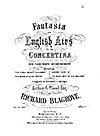 Fantasia on English Airs for the Concertina
Fantasia on English Airs for the Concertina
-
by Richard Blagrove
-
Fantasia on English Airs for the Concertina. With Piano-Forte Accompaniment.
Introducing "The Curly Headed Ploughboy", "The Banks of Allan Water",
"Cherry Ripe", & "The Roast Beef of Old England".
Composed & Dedicated to his Pupil Arthur G. Theed, Esq.
by Richard Blagrove.
London, C. Wheatstone & Co., Inventors and Patentees of the Concertina.
20, Conduit St., Regent St., W. Where may be had all Mr. Richard Blagrove's compositions.
Price 6d. [No date. 11 pages.]
-
Posted 15 November 2005
-
» read full arrangement in pdf
-
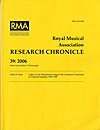 Ladies in the Wheatstone Ledgers: the Gendered Concertina in Victorian England, 1835–1870
Ladies in the Wheatstone Ledgers: the Gendered Concertina in Victorian England, 1835–1870
- by Allan W. Atlas
- This study looks at the 978 women for whom there are 1,769 transactions—about 12% of the
total—recorded in nine extant Wheatstone & Co. sales ledgers that list the firm’s day-to-day sales
from April 1835 to May 1870. It is in two parts: (1) an Introduction, which analyses the data presented
in the Inventory from a demographic-sociological point of view and places Wheatstone’s commerce
with women into the context of its business activity as a whole; and (2) the Inventory (with
three appendices), which lists every transaction for each of the 978 women, identifies as many of them
as possible, and offers a miscellany of comments about both the women and the transactions.
Royal Musical Association Research Chronicle v. 39 (2006). 239 pages.
Briefly,
the roster of Wheatstone’s female customers reads like a list of Victorian England’s rich-and-famous:
the Duchess of Wellington and 146 other members of the titled aristocracy (more than twice as many
as their male counterparts), the fabulously wealthy philanthropist Angela Burdett Coutts, members
of the landed gentry, and such mainstays of London’s musical life as the guitarist Madame R. Sidney
Pratten, the organist Elizabeth Mounsey, and the contralto Helen Charlotte Dolby, as well as a large
number of Professors of Concertina.
- Posted 21 March 2007
- » read full article
-
 The Concertinist's Guide
The Concertinist's Guide
-
by John Hill Maccann
-
The Most Simple Modern Methods; How to Play
Correctly, With or Without a Tutor
8vo. London: Howard & Co., 1888.
Images from a microfilm of a copy at the Bodleian Library, replacing
a British Library copy destroyed in World War II. (Former British Library
shelfmark D-7808.c.14.(14.), replaced by British Library microfilm
Mic.A. 10532(4), Bodleian Shelfmark 17426 e 3(2).) Also a full
transcription which is searchable in the Adobe PDF reader. 50 pages.
-
Posted 15 November 2001
-
» read full document in pdf
|







